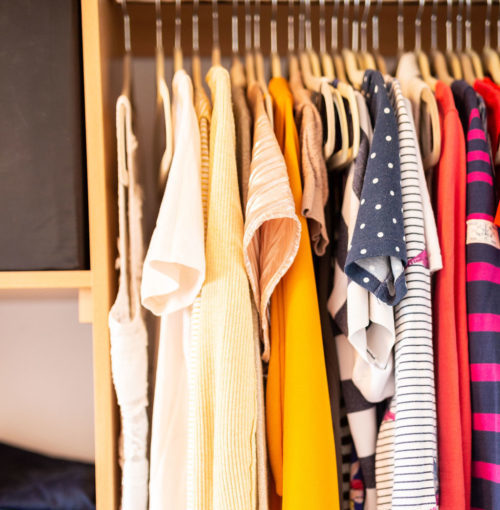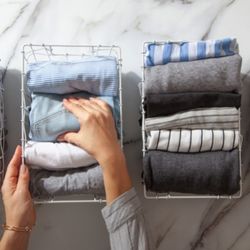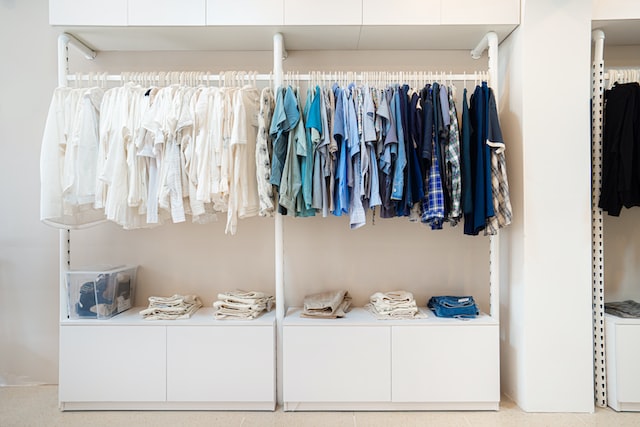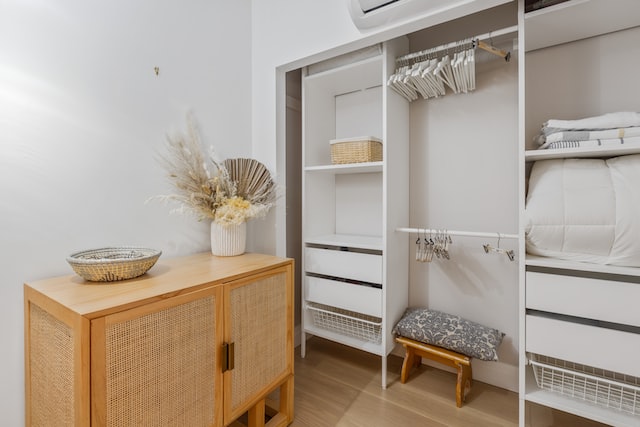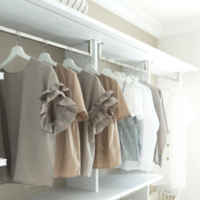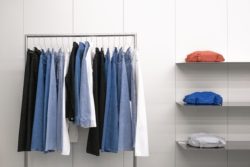It’s National Organising Week and the theme is how organising and decluttering skills can save money. One of the things we love about organising is that it doesn’t have to cost anything! You can use what you have and upcycle when it comes to storage. And forming new habits and systems isn’t always easy…but you don’t have to spend money to do it.
To kick off NOW 2022, we’re delighted to share this new blog post by Rachel Cordingley (A Tidy Mind West & North Yorkshire). Rachel has worked with many clients and their wardrobes. Whether they need a ‘wardrobe detox’, declutter or rearrange (click here for wardrobe decluttering tips). Or the implementation of new storage, containment, labelling, habits tweaking or a brand new organisational system, Rachel connects with what each client needs. Once a wardrobe is functional, it has the capacity to be a source of joy (and reduces the chances of a ‘floordrobe’ or ‘chairdrobe’ occurring!) Read on for tips on how to finally organise your wardrobe:
Wardrobe Issues
If any of the below are an issue, you may need a clothes and wardrobe organise:
- Is your wardrobe overflowing and disorganised?
- Is it difficult to put clothes and accessories away?
- Is it a challenge and to find the things you want to wear?
- Have you changed size or vary in size and some garments don’t fit?
- Have you forgotten what you have in your wardrobe?
- Has sorting out your wardrobe been on your to-do list for some time?
- Do you keep putting off your clothing sort out?
Well, if so, you are not alone. And we also want to highlight that whilst many of our clients are female, we do work with male clients who also feel overwhelmed by their wardrobe. So the below tips apply to all genders and we have some specific tips for men at the end of the post.
Whether you have a compact space for clothes or a generous dressing room, help is at hand with some Tidy Tips:
Storage Solutions
The first piece of advice is to avoid purchasing new storage until you have decluttered your wardrobe and know what you’re going to keep. You may well not need any new storage at all. After decluttering:
- Consider the volume of items you have and the space available for storage. Plan how best it can all work together
- Do you have enough hanging space? Would an extra set of drawers be useful? Consider what should be hung up versus what needs to be folded in a drawer or on a shelf
- Are you someone who needs open storage to you can see what you have at a glance? Or do you prefer the clean, minimalist look or closed doors?
Hanging Spaces
- Dresses, long tops, trousers, skirts, anything flimsy, strapless, made from easily creased material or asymmetrical – are generally better hung up
- Might you need double hanging space? Some wardrobes have ‘dead space’ where you could install an extra row and a tension rod is an easy, cheap way to add one. You could utilise a corner unit to create a large amount of room in a smaller space.
- Do you have enough hangers? And the right kind of hangers? Or are you hanging tops on hangers designed for skirts? Thin or ‘skinny’ hangers take up minimal space, compared to wooden or plastic ones. The thin velvet flocked hangers work well for most items and prevent items from slipping off. They are very inexpensive too. They can also be made into skirt hangers with matching clips. Aesthetically, consider the uniformity of matching coat hangers and coat hangers all facing the same way.
Drawers
- Smaller items may need be in drawers but contained into inserts, boxes or containers. You could insert compartmentalised jewellery trays or any kind of small open boxes for hair accessories or make up. Ice cube trays, Tupperware, ramakins and open egg boxes are a great upcycling solution
- Clothes such as t-shirts, jumpers, scarves, leggings and jeans can work well in drawers, either rolled or vertically folded as per the Kon Mari Method
- To organise the inside of underwear drawers, sock drawers or sports wear drawers, consider using larger drawer dividers / open boxes. These will enable similar items (e.g. bras / tights) to be stored together but categorised accordingly
Shelves
- Many people need to utilise shelves to store clothes. However, do you want to wear the jersey which is at the bottom of a pile on a shelf? And at this point do they all come tumbling out? To make shelves look tidier and to make access easier, add storage boxes / baskets. Vertical folding within the boxes makes items more visible
- If you are going to stack folded T-Shirts or sweaters on top of each other, think like a shop assistant and only stack 3 to 6 (depending on thickness)
- You could also vertically fold or roll garments on shelves to prevent them from becoming messy.
Combination Storage
- It’s likely that you’ll need a variety of hanging space, drawers, shelves, baskets and hooks if you want to finally organise your wardrobe. Systems such as IKEA Pax are great for this but you can tweak what you have by adding free standing drawer units or extra shelving to the insides of wardrobes
Logical Organising
- Keep it simple by starting with only pulling out any items which have dropped on the floor or fallen off their hangers. Gather up any dirty or clean laundry. Endeavour to put everything away and give everything a ‘home’
- Then go item by item and make sure it is in the right place. For example:
- Long dresses in the floor length section of any wardrobe
- Tops / trousers / skirts in the half-length sections of a wardrobe or if you have an upper and lower rail
- Logical organisation in the case of upper and lower rails:
a) Tops on the upper rail for the upper half of your body
b) Trousers and skirts on the lower rail for the lower half of your body

- Use the bottom of the wardrobe for footwear. Shoes also work well on shelves or in cubby holes. Sandals or pumps could be kept in boxes and long boots could be hung up
- Use the top shelf of a wardrobe for handbags. Or consider hanging bags on hooks
- Keep items such as bras / pants / tights / socks in drawers. Ideally each category of item would having it’s own drawer, or section of a drawer. Otherwise using drawer dividers (cardboard shoe boxes are a great upcycling idea)
- Keep other items such as nightwear / sportwear in boxes on shelves. Or allocate a drawer per category
- Keep accessories such as jewellery, make up and hair adornments together. Ideally in a dressing table or bathroom drawers. Or wherever you have your mirror to do hair and make-up. Remember the golden rule of keeping the most frequently used items in closest reach
- If you use a hairdryer or hair straighteners / hair curler daily, you could keep them in a box or an a wall mounted holder or hook. This way, you can keep them plugged in at the wall
How To Maximise Small Spaces
Even the most compact spaces can be organised with careful space optimisation:
Declutter
Always simplify first. Consider donating or selling clothes as follows:
- Some experience the effect of magic wardrobes shrinking their clothes when they reach a certain age. Be realistic about whether the clothes are ever likely to fit again and embrace your body as it is now
- Clothes which were given to us but we don’t like
- Clothes which cost a lot of money and make us feel guilty if we don’t wear them
Organise
- Maximise what you can hang with slim hangers. You can hang several camisoles or vest tops off of one hanger. A number of scarves may also be hung on one hanger
- Categorise the hanging space into dresses e.g., by length order. Trousers can either clip hung or folded onto the bottom rung of a trouser hanger, but whichever – consistently. The clip hangers use more space so trousers can also be fed through a multi use hanger. Finally, keep all skirts on clip hangers as not all skirts have skirt hooks
- Vertically fold things into drawers or storage boxes which also makes clothes much more visible and easier to find
- Consider adding hooks to the inside or outside of wardrobe doors, behind doors, on walls or any available vertical surface. Hooks can be used to store tote bags, handbags, jewellery, dressing gowns, towels, scarves or ‘next days outfit’
- There may be ‘dead space’ you can use to add open shelves. On the shelves you can keep boxes of small items or horizontally folded clothing.
- If you’re short of shoe storage, look for an ‘over the door’ shoe organiser with compartments and these are available very inexpensively
- Use ‘under the bed’ slide out containers or drawers to use this space to it’s maximum capacity
- You can also consider colour coding your clothes for ease of finding what you need for a special occasion
- Finally, if you’re still struggling for space, you may need to store half your wardrobe somewhere else out of season. To save room and money on storage, you could wrap your out of season clothes in bin bags, tape them up and add sticky labels.
Men Can Have Organised Wardrobes Too
When it comes to clothes and wardrobe organisation, men can appear to be neglected. However, exactly the same tips above apply to both genders. The below extra tips may also be useful:
- Use wide, felt hangers for shirts as they are unlikely to slip off these
- Roll belts into small containers (upcycled glass ramekins work well!) or use a hanger or special belt hanger. These hangers can either be wall mounted designed to fit in wardrobes
- Tie racks are a space saving option or ties can simply be fed over hangers or hooks
- Hats, caps and beanies can be placed inside each other on shelves or hung on hooks
- Consider colour coding clothes and shoes. We often choose items based on their colour so this makes them easier to find
- Avoid keeping trainers and other shoes in shoeboxes, unless they are infrequently used as it’s an extra step and uses more space. Plus you can repurpose the shoe boxes as drawer dividers
Conclusion
There are a myriad of ways to organise your wardrobe and there may be some trial and error until you declutter to the extent that’s right for you and find the right systems and storage. The most important aspect is that it is realistic to maintain. As with all home organisation, keep in mind the ground rules of 1) only keep what you will wear and 2) assign a home to every little thing. Then aim to keep similar items together (categorising) and have more frequently used items in easier reach. Your wardrobe can be a source of joy full of items you have intentionally chosen to enhance your life.
Thanks again to Rachel for providing the content for this article. Keep an eye on the blog for more content to celebrate National Organising Week 2022.

